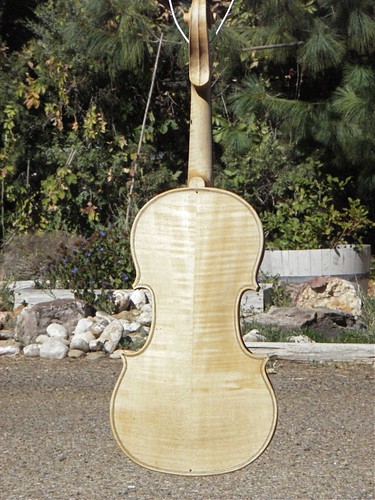
Monday, September 27, 2010
Getting a sun-tan
Finally to the point where I can put the fiddle out in the sun, to get a tan -- adds contrast to the wood. Here it is just out. I have used a little strong coffee -- Italian roast, of course! -- to lightly stain the wood. We're expecting the rest of the week to be sunny and unseasonably warm, so I'll try to take advantage of it.


Friday, September 24, 2010
Violin Button
Laying out the button. It's a bit bigger than I'll end up with, but it's a place to start.
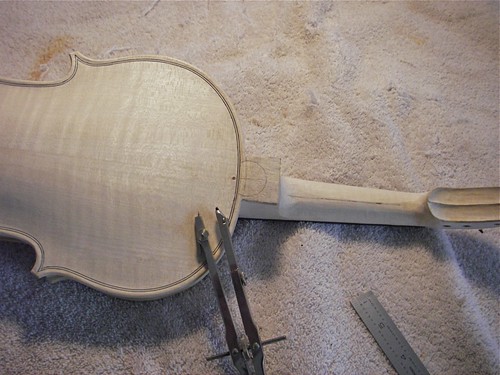
I find it tough to get the button round, follow that upwards towards the fingerboard, expanding, along the neck heel, then blending it into the neck. I have a couple templates, but much of it is done by looking at the shadows, and feeling the neck with my left hand, as if playing it.
Here is where I'm leaving it tonight. Not finished, but I want to look at it with fresh eyes next time. After this, I'll clean up the wood, then put it out to suntan a while.
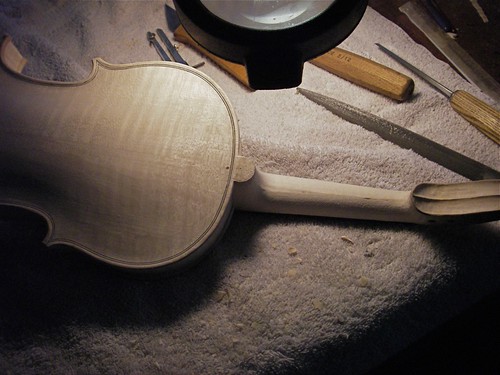

I find it tough to get the button round, follow that upwards towards the fingerboard, expanding, along the neck heel, then blending it into the neck. I have a couple templates, but much of it is done by looking at the shadows, and feeling the neck with my left hand, as if playing it.
Here is where I'm leaving it tonight. Not finished, but I want to look at it with fresh eyes next time. After this, I'll clean up the wood, then put it out to suntan a while.

Thursday, September 23, 2010
Fitting the violin neck.
Set the neck today. I think this is one of the toughest jobs in fiddle-making. You have to get the angles right in three-dimensions, with no flat surfaces to measure from. A sharp gouge, taking a little wood at a time. And, I set the angle just a little high, I hope, to account for some dropping with string tension.

Also set the saddle in place, the little piece of ebony at the other end, which supports the tail-loop that holds the tailpiece (which holds the one end of the strings).
I'll let it set in the clamp overnight, then work on finishing the button -- the extension of the back under the heel -- as well as the final neck profile.

Also set the saddle in place, the little piece of ebony at the other end, which supports the tail-loop that holds the tailpiece (which holds the one end of the strings).
I'll let it set in the clamp overnight, then work on finishing the button -- the extension of the back under the heel -- as well as the final neck profile.
Sunday, September 19, 2010
Violin neck, shaping prior to fitting.
With the neck in the vise, I make a series of cuts to remove wood from the side. Someday I'd like to get a really nice saw, but right now I have a cheap Xacto saw, and it works. The plastic bag is around the scroll to keep it from getting so dirty.

With another couple of cheap tools -- the flat chisels with plastic handles, though well-sharpened, I remove the excess wood from the side. Turn it over and do the same on the other side.
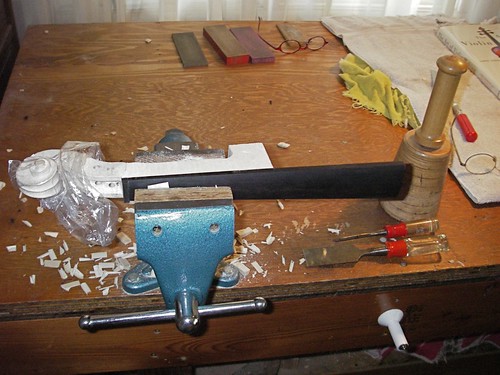
Using calipers and a ruler, I measure the thickness of the neck with the fingerboard. I'll mark a safe line running along the side to show how much wood I can remove. The small grey template between the ruler and neck is to show me both the shapes of the chin and heel (outside edges) as well as the finished thickness of the neck itself (inner arched cutouts).

Clamping the neck in place, I again make a series of cuts to remove some excess wood.
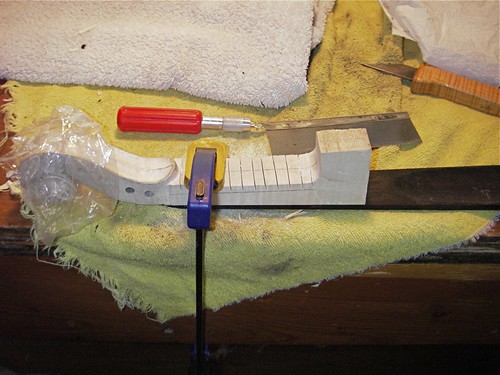
Using rasp and knife, I whittle the neck down to a reasonable, though still oversized, shape. I want to spend good time on the heel end of the neck, getting the angle and lines right before cutting the mortise in the body.
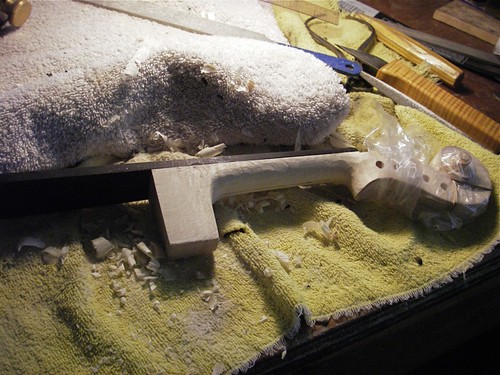

With another couple of cheap tools -- the flat chisels with plastic handles, though well-sharpened, I remove the excess wood from the side. Turn it over and do the same on the other side.

Using calipers and a ruler, I measure the thickness of the neck with the fingerboard. I'll mark a safe line running along the side to show how much wood I can remove. The small grey template between the ruler and neck is to show me both the shapes of the chin and heel (outside edges) as well as the finished thickness of the neck itself (inner arched cutouts).

Clamping the neck in place, I again make a series of cuts to remove some excess wood.

Using rasp and knife, I whittle the neck down to a reasonable, though still oversized, shape. I want to spend good time on the heel end of the neck, getting the angle and lines right before cutting the mortise in the body.

Thursday, September 9, 2010
Cello hairball
Although many musicians find it hard to believe, hairballs are common in instruments, particularly violins and violas.

Musicians shed, small debris falls in, and over time, a quiet little ball is formed, rolling around inside the instrument. This one is a little unusual, being from a student-level cello, and measures about an inch in diameter. For metric folk, that's about 2-1/2 cm .

Musicians shed, small debris falls in, and over time, a quiet little ball is formed, rolling around inside the instrument. This one is a little unusual, being from a student-level cello, and measures about an inch in diameter. For metric folk, that's about 2-1/2 cm .
Thursday, September 2, 2010
Finding a new old tool I already had
I had a bass in the shop for repair. It had a couple cracks in the heel and a fingerboard that had been reglued in place, or almost in place, with some unknown glue. An amateur repair, the fingerboard had slipped after it was glued, but before the glue had set. Basically a mess. I was able to get the fingerboard off, but did not recognize the glue. It was still plastic, and a dark brown in color. To further complicate matters, a small chunk of the fingerboard had been left glued to the neck prior to the application of this brown glue.
I managed to lift off the small chunk of fingerboard attached to the neck, but none of my known methods of glue removal had much effect on this soft but stubborn glue. In desperation, I tried an old plane I had lying about. I got it several years ago at an antique shop for $20. Hadn't done anything with it, and it was in rough shape.
It actually worked fairly well. I was able to plane the glue from the fingerboard, and then from the neck. And the plane felt pretty nice in my hand.
So, I took the plane apart, cleaned up the blade and the cap, flattened the sole a little bit with a sanding board, and sharpened the blade. This is it in the photo. An old No. 5. It is resting on a piece of poplar about 16 inches long. The shaving is from the first stroke I took with the newly cleaned up plane, a full-length shaving, about 0.011-inch thick -- sometimes it's nice to move a little wood.
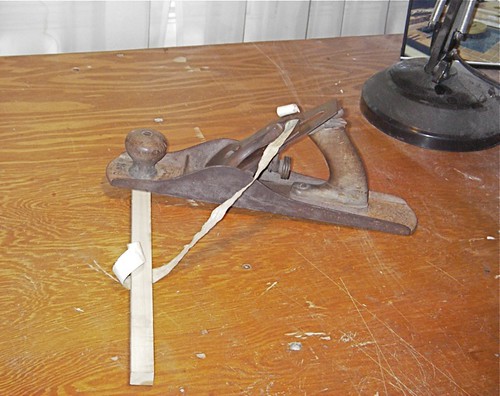
I'd been wanting a jack plane, and I just might have something here that works in that capacity.
Here's the bass with the neck and fingerboard newly cleaned of plastic glue. I have used hide glue to glue the cracks in the heel, held by the clamp, but will actually resort to a carriage bolt down through the heel to hold it together. On the fingerboard, you might be able to see the small chunk of wood I had to remove from the neck and glue back in; it's about 1/3 the way from the left end, on the lower edge.
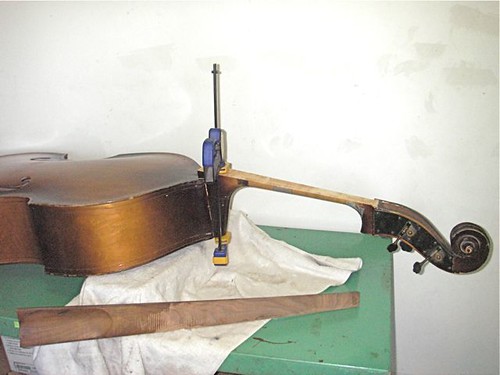
I managed to lift off the small chunk of fingerboard attached to the neck, but none of my known methods of glue removal had much effect on this soft but stubborn glue. In desperation, I tried an old plane I had lying about. I got it several years ago at an antique shop for $20. Hadn't done anything with it, and it was in rough shape.
It actually worked fairly well. I was able to plane the glue from the fingerboard, and then from the neck. And the plane felt pretty nice in my hand.
So, I took the plane apart, cleaned up the blade and the cap, flattened the sole a little bit with a sanding board, and sharpened the blade. This is it in the photo. An old No. 5. It is resting on a piece of poplar about 16 inches long. The shaving is from the first stroke I took with the newly cleaned up plane, a full-length shaving, about 0.011-inch thick -- sometimes it's nice to move a little wood.

I'd been wanting a jack plane, and I just might have something here that works in that capacity.
Here's the bass with the neck and fingerboard newly cleaned of plastic glue. I have used hide glue to glue the cracks in the heel, held by the clamp, but will actually resort to a carriage bolt down through the heel to hold it together. On the fingerboard, you might be able to see the small chunk of wood I had to remove from the neck and glue back in; it's about 1/3 the way from the left end, on the lower edge.

Subscribe to:
Posts (Atom)
